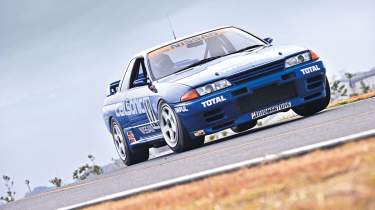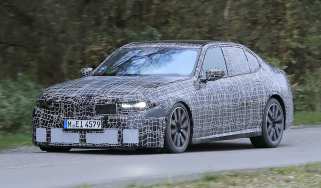Nissan Skyline GT-R R32 Calsonic race car
evo goes to Japan to become the first press outlet to drive the Calsonic GT-R
So this is what déjà vu feels like. The blue and white livery. The absurdly wide tyres. The crazy camber and pugnacious stance. I’ve never stood next to this car in my life, yet it all looks so familiar, like I’ve driven it a thousand times. Actually I have driven this car a thousand times, but only in the virtual sense, courtesy of the PlayStation phenomenon that is Gran Turismo. Today, to my utter delight, I get to drive it for real.
To be honest I’m not sure who’s more nervous of today’s exercise: me, or the men from Nismo. Behind the friendly smiles and respectful bows, I can sense the unique tension that comes from placing an awful lot of trust – and perhaps the most significant slice of Nissan racing heritage – in the hands of a foreign scribbler they’ve never met. A few days prior to the test drive, I’d been asked to supply a racing CV (Nismo has never let a journalist drive one of its historic racing cars before), so I gave them the whole nine yards. I don’t think the stunning pair of pole positions and lights-to-flag wins at Cadwell Park in the 1997 Mighty Mini Challenge cut much ice, but more modest success at the Nürburgring, Pikes Peak and Bonneville Speed Week clearly did something to convince them I’m not a complete muppet. Phew.
You don’t need to be a dedicated student of motorsport history to know the Skyline GT-R was a force to be reckoned with during the early 1990s. These were the days of Group A, when a more grounded set of regulations restored some sanity after the madness of Group B. At the time it probably seemed a little tame, but the enduring genius of Group A is that although the touring cars and rally cars it spawned were highly modified, they were amplified versions of the homologated road cars you could buy, or at least aspire to buy. Consequently there was variety, innovation and scope for marques to go racing with genuine road-based cars. It also provided the impetus for a generation of talented engineers to geek-out on the details. It was a win-win for racers and road drivers alike, for so long as there were sufficient showroom examples produced, pretty much anything went.
In the case of the R32 Skyline, that meant six cylinders, twin turbos, all-wheel drive with computer-controlled torque split and all-wheel steer. Looking back, this was the racing equivalent of arriving at a knife fight with a machine gun, but there’s no question it made for spectacular racing, both in Japan and abroad. In Europe the Group A R32 Skyline creamed the opposition in the 1991 Spa 24 Hours, while in Australia the GT-Rs kicked seven shades out of the V8 Fords and Holdens and used E30 M3s as toothpicks with which to prize out the gristle left from chewing up RS500 Cosworths. Between them Nissan drivers Jim Richards and Mark Skaife won the 1990, 1991 and 1992 Group A championships (the forerunner to V8 Supercars), plus the ’91 and ’92 Bathurst 1000 races. Their exploits prompted the Australian press to come up with that immortal nickname for the GT-R: ‘Godzilla’.
However, it was at home in Japan that the legend of the GT-R was strongest. In the All Japan Touring Car Championship the Group A R32 Skyline was literally unbeatable, winning 29 races from 29 starts across four seasons of total dominance. By 1993 such was the GT-R’s superiority that the JTCC was all but a one-make series with no fewer than sixteen R32s slugging it out, but the spectacle still drew 94,500 fans to watch the final race at Fuji in October 1993 – the last-ever for the Group A monsters. During that all-conquering era, one GT-R above all others – the Calsonic car – became little short of a deity, becoming champion in the first and last of those four epic seasons.
It’s hard to think of another racing car that possesses such deep-rooted cultural significance in its homeland, yet also has cult status on a truly global scale. I certainly doubt there’s a more iconic or significant competition car in Japan, nor a cooler or more intriguing machine for our generation of Western petrolheads. No wonder the boys from Nismo look a little edgy at letting me loose in it.
Our venue is Grandrive, a purpose-built test track located within the confines of a Nissan manufacturing plant in Yokosuka City, an hour or so from downtown Yokohama. It’s a rather faceless place. Once beyond the security gates you drive through a seemingly endless warren of low-rise factory buildings before finally emerging into the open expanse of Grandrive itself. The track is much bigger than I expected, but it’s very definitely a facility designed for modest road cars, not fire-snorting 650bhp GT-Rs. The track is two lanes wide and has markings like a typical public road, which make it look narrower. There’s no run-off and plenty of barriers, but the good news is there’s a generous straight and a very long corner that feeds onto it, plus a few chicanes, a couple of hairpins and a bit of gradient courtesy of an incongruous man-made hillock.
The Nismo crew scurry around the Calsonic GT-R like worker bees tending to the queen. A small man hefts down on a very long torque-wrench pole, putting a few extra newton metres into the huge centre-lock wheels. While it’s up on its built-in jacks, a second technician fires the car up and works gently up and down the gears, all four wheels spinning as the engine and transmission warm through with zero loading.
It’s the perfect time to have a proper nose around the car and drink in all the details. The front and rear tracks are wider than standard, and the enormous 10in-wide rims are right on the Group A limit, being 2in wider than the road car’s. Combined with the hefty negative camber angles – just over 5deg at the front and 3deg at the rear – it possesses a fantastic bodybuilder physique, one accentuated by the fact the bodywork and aerodynamics are standard. The metamorphosis from road GT-R to Group A monster meant every component was either made lighter, stronger or more potent, yet the essence of the road car was never lost.
The RB26 DETT straight-six engine is a brute, with every aspect of its cooling, breathing and fuelling optimised within the Group A regulations. Engine internals and the block itself are also uprated. In its heyday power ranged anywhere between 550 and 650bhp depending on the year and the race. No one’s saying what it’s developing today, but something tells me this 1260kg car is not going to want for performance.
Some of the more arcane aspects of Group A regulations, such as the need for standard production door cards and dashboards, must have seemed a bit pedantic to the teams and engineers, but now they add to the charm and the relevance of the car. It looks and feels like the stripped-out road car it is, not a carbon-clad caricature like today’s Super GT and DTM cars. Motorsport’s rule makers would do well to remember this.
The Nismo crew’s pre-drive rituals and the arrival of Katsumasa Chiyo, Nismo’s Junior Team GT300 driver in the Japanese Super GT series, add to the anticipation. Chiyo-san has been enlisted to shake Godzilla down before I drive it. I’m glad he’s here, but he looks as apprehensive as I feel; unsurprising given he was only four years old when this car was in its prime and has spent all but one of his ten seasons in motorsport racing karts or Formula 3 cars.
I’m mildly disappointed to find the car on wet tyres. Yes, there are a few damp patches on track after some overnight rain, but it’s a cool, breezy day so the tarmac will soon be dry, especially after Chiyo’s warm-up laps. He’s clearly under instructions to take things steady, keeping the revs down and carefully feeling his way through the five-speed dog ’box. Still, the sound is epic; a hard-edged, forced-induction holler spliced with a barely silenced straight-six howl that bounces off the slab sides of the distant factory buildings like thunder.
After a few laps, Chiyo returns to the makeshift paddock. Out he hops, up pop the air jacks, off come the wets and on go a set of slicks! I’m pleased, but I’m also instantly concerned about the prospect of feeling my way around a strange circuit in an unfamiliar car on cold rubber. That’s often the way with these track tests, but it still adds an extra frisson of anxiety to an already pressure-laden drive. I have a quiet word with myself in the restroom before striding towards the GT-R and the assembled crowd of Nismo technicians and managers, who are all wearing their best please-don’t-crash-it faces.
As always, when the time comes, it’s great to finally be strapped in. Helmet on, door closed, isolated from the rest of the world and with nerves steadily subsiding, there’s just enough time to slowly breathe in the heady petrol fumes and intoxicating history of this magnificent car before I’m told to get going. With the ignition comes a cacophony of noise from the fuel pumps and transmission coolers. Then the engine fires with a meaty, pulsing throb, followed by the industrial whine of the gearbox as I depress the weighty but not uncomfortably heavy clutch, pull left and back to find first gear and chunter out onto the track.
It’s a joy to be in this car, not least because you sit high enough to see out of it, unlike today’s race cars where the driver’s eye-line is level with the top of the dashboard. As a result I’m not left wondering where to place the car on the track, which means I can immediately focus on enjoying myself and hopefully scratch the surface of what this fabulous car can do.
The gearshift is initially a little disconcerting, but only because it’s unencumbered by synchromesh and slots between gears so fast and free that I’m not entirely sure which gear I’ve got until I let the clutch up. Thankfully, once I’ve got myself orientated and my left arm has built a little muscle memory, the ’box is sensational, thriving on punchy inputs pushed home with increasing speed and confidence.
It needs to be a quick shifter too, for the way the GT-R devours each ratio is spectacular. The boost comes in a solid, intensifying rush that pins you in the seat and makes you laugh out loud, gear after gear after gear. There’s seemingly no abatement in the GT-R’s appetite for ratios and it pulls as hard in fifth as it does in third. With no wings to speak of, the R32 is free from downforce-induced drag. That apparently made the Group A GT-Rs a bit lively down the long Kemmel and Conrod straights at Spa and Bathurst respectively, where they could get a bit floaty as they nudged 190mph. It must have been a wild and wonderful ride.
The noise from the engine and transmission is all-pervading and truly monstrous, filling the car and your head with the most extraordinary bellow, punctuated by the fizz of those two furiously spinning turbos. I’ve been given a 7000rpm rev limit, which feels like plenty, but I suspect leaves plenty more to come. Just how much I’m unaware until back in the UK, when some additional research for this feature reveals that the Group A cars would regularly rev to 8500rpm in race trim…
The steering is power-assisted, as you’d expect with that much rubber cranked over with quite so much camber. It’s light and darty, but calms a little and gains feel once the tyres have heat in them. Teams in Japan and Australia tried different ways of dialling-out understeer. The former played with the HICAS four-wheel steering and ATTESA E-TS torque controller as well as the suspension’s camber and castor; the Gibson Motorsport team in Australia disabled the HICAS and worked on a suspension set-up more suited to rear-wheel drive, then optimised the torque split via the ATTESA E-TS system for each circuit. Both found a sweet spot, but as they never raced each other, nobody knows which would have been quickest of all.
There’s no question either car would take some getting used to on a full-blooded racetrack, for even at Grandrive with me at the wheel, the way the Calsonic car changes direction is pretty remarkable. It’s stiff too, with very little roll and a propensity to get deflected by mid-corner bumps, as I discover once I begin to carry some proper speed through the exit of the long fourth-gear corner onto the start-finish straight. You can feel it winding itself up in the tighter corners, especially as you begin to feed the power in, and it even picks the inside wheels up at times. The revs flare momentarily when it does so, but then the car settles, hooks up and effs off down the next straight. It’s this turn-in agility followed by the ability to put all its power down on the way out of corners that made the GT-R such a formidable weapon. A Group A Sierra RS500 was lighter and had 500-550bhp, but with rear-wheel drive it couldn’t match the traction, especially over longer runs. To be fair to Ford, nothing else could.
That’s not to say the R32 was an easy car to take to the limit, though. If you trawl YouTube for footage, it’s clear these Group A GT-Rs took some holding on to, especially somewhere like Bathurst where they leapt, bounced and clawed their way over Mount Panorama. It looks brutal, and from where I’m sitting it feels brutal, even at the pace I dare to run at, but it’s also a car that’s transparent and simple to interpret. There’s no mystery about what it does and you don’t need to be a pro to feel for where the limit might lie. Of course, feeling for it is one thing, finding it is another matter (and not something to be attempted in six laps of Grandrive), but at least it seems the R32 speaks our language, that of mechanical grip, not the daunting, alien cipher of downforce.
The brakes – big AP rotors with no ABS – are massively powerful, but feelsome too, which is handy as every downshift needs some old-school heel-and-toe to match revs with road speed. Like the rest of the car it’s a tremendously satisfying challenge, one that puts you in the heart of the action and keeps you there throughout the lap. Again, it’s a totally different experience to a modern paddle-shift touring car or GT car, which render your left foot redundant on upshifts and do all the blipping on downshifts. This is a car you have to drive with sympathy, accuracy and dexterity for every yard of every lap. As such it’s a machine that rewards a more classical skill set and goes beyond the binary 21st century challenges of nailing braking points and maximising minimum corner speed.
There’s something ironic about a car famed for its technology and hero status amongst virtual racers being such an analogue, organic experience to drive. Then again, GT-Rs are and have always been far more challenging and characterful than their ‘computer game’ stigma suggests. There were successful GT-R racers before and after the R32, but none epitomises all that’s great about the breed and the brilliance of Japanese motorsport in general more vividly than this gnarly blue and white veteran.
Find used Nissan Skyline's for sale on the Classic and Performance Car site here.


